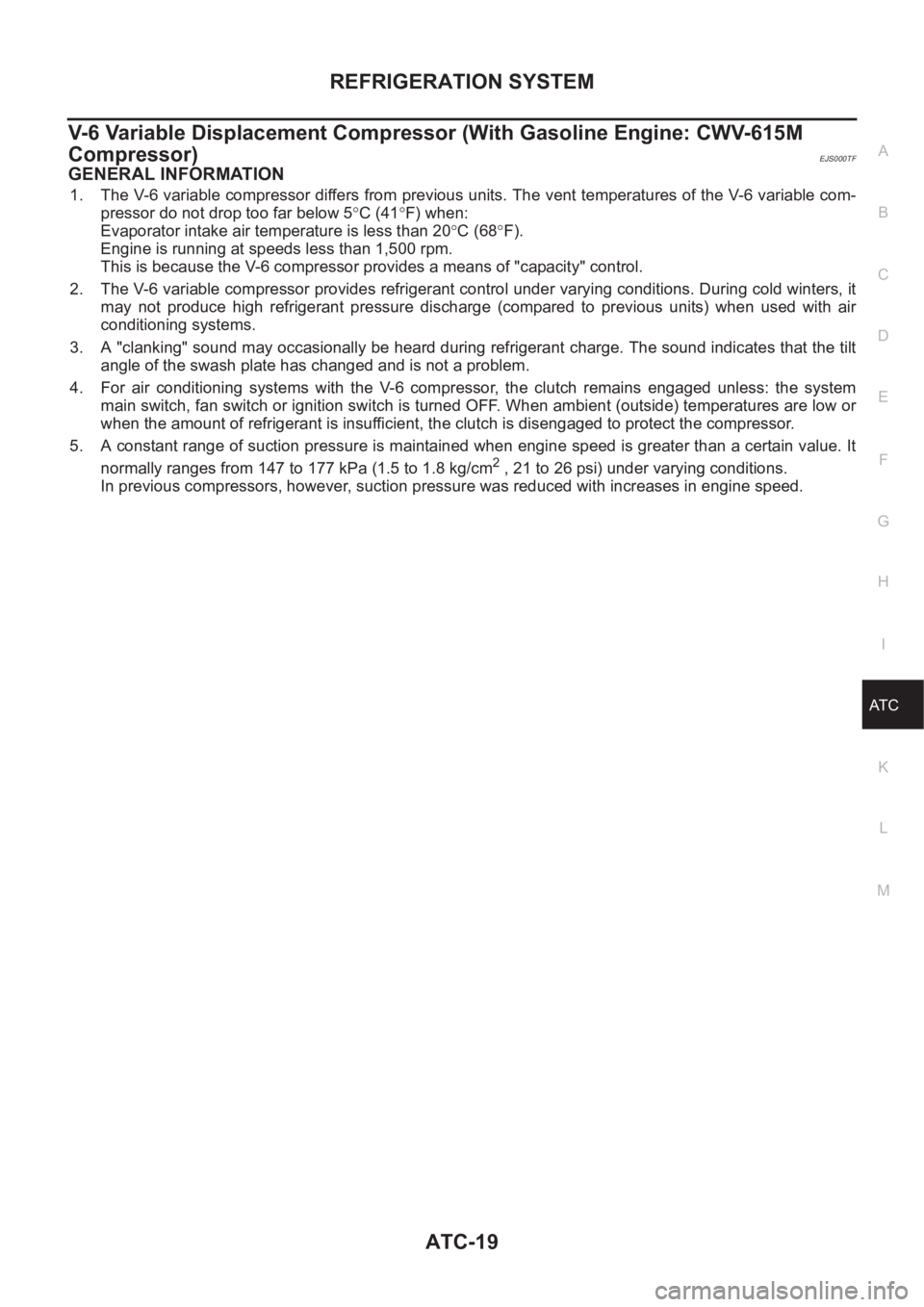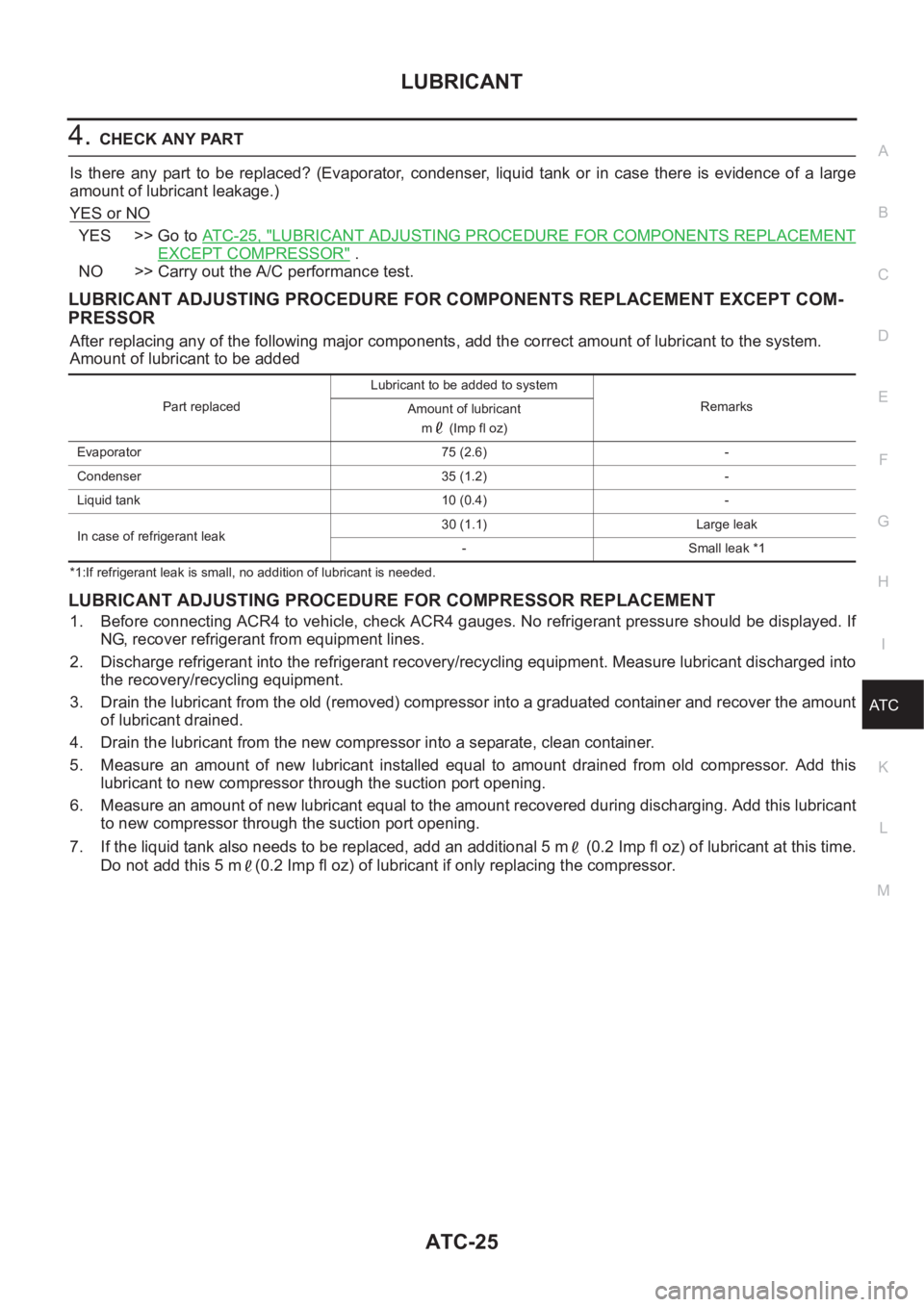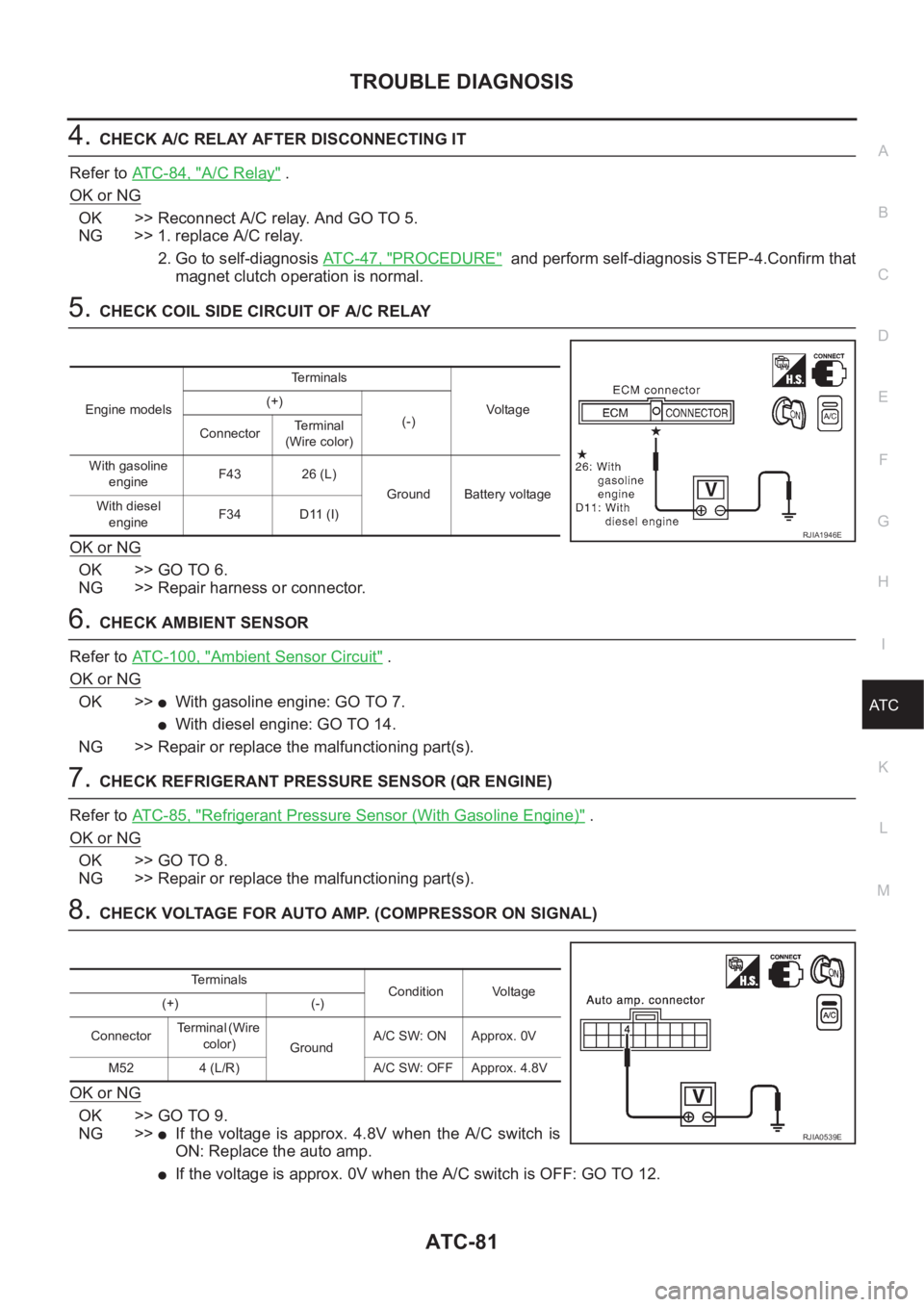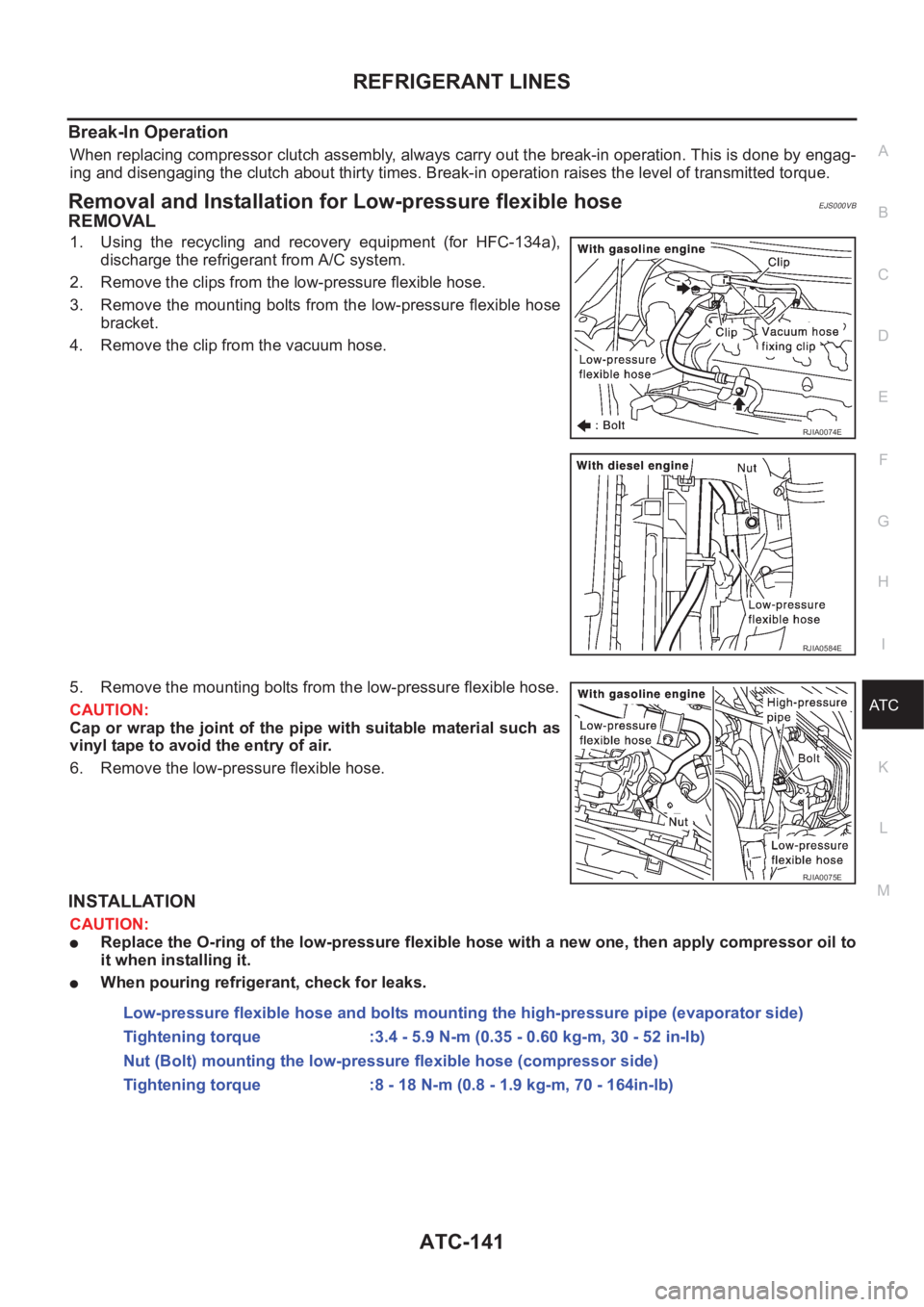Page 3295 of 3833

REFRIGERATION SYSTEM
ATC-19
C
D
E
F
G
H
I
K
L
MA
B
AT C
V-6 Variable Displacement Compressor (With Gasoline Engine: CWV-615M
Compressor)
EJS000TF
GENERAL INFORMATION
1. The V-6 variable compressor differs from previous units. The vent temperatures of the V-6 variable com-
pressor do not drop too far below 5°C (41°F) when:
Evaporator intake air temperature is less than 20°C (68°F).
Engine is running at speeds less than 1,500 rpm.
This is because the V-6 compressor provides a means of "capacity" control.
2. The V-6 variable compressor provides refrigerant control under varying conditions. During cold winters, it
may not produce high refrigerant pressure discharge (compared to previous units) when used with air
conditioning systems.
3. A "clanking" sound may occasionally be heard during refrigerant charge. The sound indicates that the tilt
angle of the swash plate has changed and is not a problem.
4. For air conditioning systems with the V-6 compressor, the clutch remains engaged unless: the system
main switch, fan switch or ignition switch is turned OFF. When ambient (outside) temperatures are low or
when the amount of refrigerant is insufficient, the clutch is disengaged to protect the compressor.
5. A constant range of suction pressure is maintained when engine speed is greater than a certain value. It
normally ranges from 147 to 177 kPa (1.5 to 1.8 kg/cm
2 , 21 to 26 psi) under varying conditions.
In previous compressors, however, suction pressure was reduced with increases in engine speed.
Page 3301 of 3833

LUBRICANT
ATC-25
C
D
E
F
G
H
I
K
L
MA
B
AT C
4.CHECK ANY PART
Is there any part to be replaced? (Evaporator, condenser, liquid tank or in case there is evidence of a large
amount of lubricant leakage.)
YES or NO
YES >> Go to AT C - 2 5 , "LUBRICANT ADJUSTING PROCEDURE FOR COMPONENTS REPLACEMENT
EXCEPT COMPRESSOR" .
NO >> Carry out the A/C performance test.
LUBRICANT ADJUSTING PROCEDURE FOR COMPONENTS REPLACEMENT EXCEPT COM-
PRESSOR
After replacing any of the following major components, add the correct amount of lubricant to the system.
Amount of lubricant to be added
*1:If refrigerant leak is small, no addition of lubricant is needed.
LUBRICANT ADJUSTING PROCEDURE FOR COMPRESSOR REPLACEMENT
1. Before connecting ACR4 to vehicle, check ACR4 gauges. No refrigerant pressure should be displayed. If
NG, recover refrigerant from equipment lines.
2. Discharge refrigerant into the refrigerant recovery/recycling equipment. Measure lubricant discharged into
the recovery/recycling equipment.
3. Drain the lubricant from the old (removed) compressor into a graduated container and recover the amount
of lubricant drained.
4. Drain the lubricant from the new compressor into a separate, clean container.
5. Measure an amount of new lubricant installed equal to amount drained from old compressor. Add this
lubricant to new compressor through the suction port opening.
6. Measure an amount of new lubricant equal to the amount recovered during discharging. Add this lubricant
to new compressor through the suction port opening.
7. If the liquid tank also needs to be replaced, add an additional 5 m (0.2 Imp fl oz) of lubricant at this time.
Do not add this 5 m (0.2 Imp fl oz) of lubricant if only replacing the compressor.
Part replacedLubricant to be added to system
Remarks
Amount of lubricant
m (Imp fl oz)
Evaporator 75 (2.6) -
Condenser 35 (1.2) -
Liquid tank 10 (0.4) -
In case of refrigerant leak30 (1.1) Large leak
- Small leak *1
Page 3321 of 3833
TROUBLE DIAGNOSIS
ATC-45
C
D
E
F
G
H
I
K
L
MA
B
AT C
17Fan control amp. control
signalIGN
ONFan speed: 1st, 2nd, 3rd, 4th Approx. 2.5 - 3.5
Fan speed: 5th Approx. 9.0
18 Blower motor feed backIGN
ONFan speed: 1st Approx. 8.0
19 Fan ON signalIGN
ONBlower fan: ON Approx. 0
Blower fan: OFF Approx. 4.8
20 Power supply for ACCIGN
ON-Approx. 12
21With gasoline engine:
Water temperature sensorIGN
ONAt idle (after warming up, approx. 80°C)
CAUTION:
The waveforms vary depending on cool-
ant temperature
With diesel engine:
Thermal transmitterIGN
ONWater temperature: 56°C Approx. 5.67 - 7.01
24 Sensor groundIGN
ON-Approx. 0
25 Intake sensor - - -
30Compressor feed back sig-
nal (With gasoline engine)IGN
ON-Approx. 0
Disconnect the refrigerant pressure sensor
connectorApprox. 5 TERMI-
NAL NO.ITEM CONDITIONVo l ta g e
(V)
SKIA0056J
Page 3357 of 3833

TROUBLE DIAGNOSIS
ATC-81
C
D
E
F
G
H
I
K
L
MA
B
AT C
4.CHECK A/C RELAY AFTER DISCONNECTING IT
Refer to ATC-84, "
A/C Relay" .
OK or NG
OK >> Reconnect A/C relay. And GO TO 5.
NG >> 1. replace A/C relay.
2. Go to self-diagnosis AT C - 4 7 , "
PROCEDURE" and perform self-diagnosis STEP-4.Confirm that
magnet clutch operation is normal.
5.CHECK COIL SIDE CIRCUIT OF A/C RELAY
OK or NG
OK >> GO TO 6.
NG >> Repair harness or connector.
6.CHECK AMBIENT SENSOR
Refer to ATC-100, "
Ambient Sensor Circuit" .
OK or NG
OK >>●With gasoline engine: GO TO 7.
●With diesel engine: GO TO 14.
NG >> Repair or replace the malfunctioning part(s).
7.CHECK REFRIGERANT PRESSURE SENSOR (QR ENGINE)
Refer to ATC-85, "
Refrigerant Pressure Sensor (With Gasoline Engine)" .
OK or NG
OK >> GO TO 8.
NG >> Repair or replace the malfunctioning part(s).
8.CHECK VOLTAGE FOR AUTO AMP. (COMPRESSOR ON SIGNAL)
OK or NG
OK >> GO TO 9.
NG >>
●If the voltage is approx. 4.8V when the A/C switch is
ON: Replace the auto amp.
●If the voltage is approx. 0V when the A/C switch is OFF: GO TO 12.
Engine modelsTerminals
Voltag e (+)
(-)
ConnectorTerminal
(Wire color)
With gasoline
engineF43 26 (L)
Ground Battery voltage
With diesel
engineF34 D11 (I)
RJIA1946E
Terminals
Condition Voltage
(+) (-)
ConnectorTe r m i n a l ( W i r e
color)
GroundA/C SW: ON Approx. 0V
M52 4 (L/R) A/C SW: OFF Approx. 4.8V
RJIA0539E
Page 3361 of 3833
TROUBLE DIAGNOSIS
ATC-85
C
D
E
F
G
H
I
K
L
MA
B
AT C
Refrigerant Pressure Sensor (With Gasoline Engine)
The refrigerant pressure sensor is attached to the liquid tank (con-
denser).
Dual-Pressure Switch (With Diesel Engine)
Thermal Protector (With diesel engine)
Check continuity between compressor harness terminal and field
coil.
RJIA0690E
SHA315F
Compressor: ON
kPa (bar, kg/cm2 , psi)Compressor: OFF
kPa (bar, kg/cm2 , psi)
Low-pressure side 186 (1.86, 1.9, 27) 177 (1.77, 1.8, 26)
High-pressure side 1,569 (15.7, 16, 228) 2,746 (27.5, 28, 398)
RJIA0691E
RHA671H
Page 3409 of 3833
REFRIGERANT LINES
ATC-133
C
D
E
F
G
H
I
K
L
MA
B
AT C
WITH DIESEL ENGINE
1. Using recycling and recovery equipment (for HFC-134a), discharge the refrigerant.
2. Remove the engine under cover.
3. Remove the compressor-alternator belt.
Refer to EM-12, "
Removal and Installation" or EM-13, "Removal and Installation of Drive Belt Auto-Ten-
sioner" for QR engine,EM-119, "Removal and Installation" for YD engine.
4. Remove the mounting nuts (bolts) from the high-pressure flexi-
ble hose and low-pressure flexible hose.
CAUTION:
Cap or wrap the joint of the pipe with suitable material such
as vinyl tape to avoid the entry of air.
5. Disconnect the compressor connector.
RHA667H
RJIA0073E
RJIA0579E
Page 3410 of 3833
ATC-134
REFRIGERANT LINES
6. Remove the mounting bolts from compressor.
7. Remove the compressor from the lower side of the vehicle.
INSTALLATION
CAUTION:
●Replace the O-ring of the low-pressure flexible hose and
high-pressure flexible hose with a new one, then apply
compressor oil to it when installing it.
●When pouring refrigerant, check for leaks.
RJIA0021E
RJIA0580E
RJIA0023E
RJIA0581E
Bolts mounting the compressor (With gasoline engine)
Tightening torque : 28.4 - 33.3 N-m (2.9 - 3.4 kg-m, 21 - 24 ft- lb)
Bolts mounting the compressor (With diesel engine)
Tightening torque : 60 - 69 N-m (6.1 - 7.1 kg-m, 45 - 51 ft- lb)
Nut (bolt) mounting the high-pressure flexible hose
Tightening torque : 8 - 18 N-m (0.8 - 1.9 kg-m, 70 - 164 in-lb)
Nut (bolt) mounting the low-pressure flexible hose
Tightening torque : 8 - 18 N-m (0.8 - 1.9 kg-m, 70 - 164 in-lb)
Page 3417 of 3833

REFRIGERANT LINES
ATC-141
C
D
E
F
G
H
I
K
L
MA
B
AT C
Break-In Operation
When replacing compressor clutch assembly, always carry out the break-in operation. This is done by engag-
ing and disengaging the clutch about thirty times. Break-in operation raises the level of transmitted torque.
Removal and Installation for Low-pressure flexible hoseEJS000VB
REMOVAL
1. Using the recycling and recovery equipment (for HFC-134a),
discharge the refrigerant from A/C system.
2. Remove the clips from the low-pressure flexible hose.
3. Remove the mounting bolts from the low-pressure flexible hose
bracket.
4. Remove the clip from the vacuum hose.
5. Remove the mounting bolts from the low-pressure flexible hose.
CAUTION:
Cap or wrap the joint of the pipe with suitable material such as
vinyl tape to avoid the entry of air.
6. Remove the low-pressure flexible hose.
INSTALLATION
CAUTION:
●Replace the O-ring of the low-pressure flexible hose with a new one, then apply compressor oil to
it when installing it.
●When pouring refrigerant, check for leaks.
RJIA0074E
RJIA0584E
RJIA0075E
Low-pressure flexible hose and bolts mounting the high-pressure pipe (evaporator side)
Tightening torque :3.4 - 5.9 N-m (0.35 - 0.60 kg-m, 30 - 52 in-lb)
Nut (Bolt) mounting the low-pressure flexible hose (compressor side)
Tightening torque :8 - 18 N-m (0.8 - 1.9 kg-m, 70 - 164in-lb)